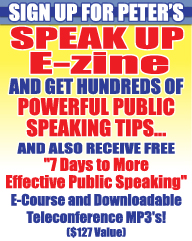Peter Fogel’s “Creating Smooth Transitions During Your Speech!”
Ever drive a stick shift in a car?
If you have, then you soon discovered if you don’t use the clutch the right way (too fast or too slow — or not at all), the gears will collide and you’ll hear an annoying and scary grinding of metal. Most new teenage drivers know this hellacious sound. (And their fathers know this hellacious sound as they curse under their breath at the thought of having to get a new clutch job.)
What you (and your father) realized at that moment was that you did NOT have a smooth transition
between gears. You also can NOT jump from first gear to third either! What you DO need is a smooth transition between all the gears and in the right order.
Well, guess what? In the world of public speaking, it’s vital you also make a smooth transition between thoughts, ideas and stories. Not doing so will create a “grinding of the gears” effect with your audience.
Now notice how I began this article. I needed a transition to talk about transitions, so I began with a story about a gearbox and driving a stick shift. I painted a picture in your mind.
You knew the title of this article, then you realized I was starting with a story about a teenage
driver grinding gears. You didn’t know how I was going to pull the two together… but hopefully I kept your attention while doing it. If I didn’t, you would have felt let down. That is the strength of having strong transitions.
Remember: Each thought… each nugget
of knowledge… each story… should flow into the next one and have continuity.
For instance, some speakers when leaving one idea or in wanting to transition to a new story might engage the audience with a joke or a humorous anecdote. Infusing humor at that particular time is an effective way to make a transition during your speech. It also informs the audience (in a subtle fashion) that you are heading into a new direction. For instance: Talking about Global Warming and next jumping into Healthcare Problems are two distinct ideas that really do not tie together well.
“The snowcaps will melt; animals indigenous to that area will have a low food supply and eventually become extinct. (PAUSE; looks out at audience) Say by a raise of hands, who here has health insurance ?”
GULP! See what I mean? Oh, sure, these distinct ideas could work under the speech umbrella of “Major Problems Facing the World” but on its own, Global Warming and Healthcare don’t really mesh.
Unless of course, if our planet is frying us like bacon, you’re going to need some good health care! If you were going to team these ideas together, you would need to massage a good transition.
No, your best option is to work on smoothly moving the listener along to your next train of thought in the simplest way possible!
Be Smooth As Silk!
Need further proof that bad transitions confuse audiences? Well, let’s take the movie-making experience as an example: When a movie jumps around from scene to scene, with no continuity — it exhausts and confuses the audience. Whether you know it or not, when you watch a film, read a great story, or play — your brain is trying to make sense of what is going on.
Now, I am going to let you in on a little secret. I am an improvisational humorist. My train of thought is very stream-of-consciousness, in-the-moment! (Which at times gets me in trouble!) And because I am very improvisational, I work with an outline so I know where I am heading with my speech but sometimes I go off on a tangent.
That said, I always make sure when I leave one topic and weave into another there is a smooth transition that does not jar my audience.
A to B to C to D!
In other words, you never want to LEAP to another idea out of nowhere. Your audience will think, “Well,
where the hell did that come from”?
Notice when you are captivated by a great speaker, their smooth transitions are SMOOTH because they’re not even noticed. The fluidity of their words and message is like water flowing over rocks. This is a vital element of their performance. Without this evenly spaced seamless progression into the next topic, a talk can get all jumbled up in the audience’s mind.
The transitions should make sense. A to B to C. Of course, you don’t want your content to be completely linear, so your audience gets ahead of you. However, you shouldn’t throw a monkey wrench and bring in topic H out of nowhere. Your ideas should have fluidity and flow with the proper segues.
Even as a humorist I need to worry about how my stories, bits, or jokes flow from one to the next. An audience who is highly entertained with humor will notice if one joke or story seems jarring as I move on to the next bit of business without a transition.
When you begin to think about making connections within your speeches to help audiences move along with you, don’t think it all has to be about words. Your body mannerisms also are part of your performance and communicate a great deal.
Another way is to stop talking. I know that’s tough for a speaker. (We hate “hearing” silence.) Nevertheless, take a moment and pause. Look out at your audience and smile.
Believe it or not, a lack of words will get you attention. Why? Because your listeners are wondering
why you stopped talking. Here you can smooth out the transition by doing a mini recap of what you just said so you can make a flowing transition into the next part of your talk/presentation.
What Do You Do During the Silence
You can even hand out some material, giving the audience time to realize a segue has taken place. Hand out a flyer summarizing your main points. Whatever you think is relevant works, as long as your audience is momentarily distracted. THEN you can effortlessly move on and continue talking.
If you want to announce that your speech is about to go in another direction, use that one-liner joke ou’ve been saving for just such an occasion. Or use a short anecdote to announce: PAY ATTENTION – CHANGE IN TOPIC. Or speak directly to your audience by posing a question:
“Okay, I just finished talking about the challenges of Global Warming…” I now want to discuss health care with you. And what do the two have in common? A lot… Okay, folks, now go with me on this… I am going to show you how they are intricately connected. More importantly, what YOU can do to change it.
See what I mean? Two different ideas — and one easily making a change into the next. You, as an audience don’t know how those two different topic ideas are connected but I, the Speakers, am going to reveal it to you. Here we are using curiosity to gain even more attention from your audience.
Look at your own speeches and your topic ideas and see if you can massage your message so you have smoother transitions for a more impactful speech!
###
|
|
|
|
|
|
|
|
















